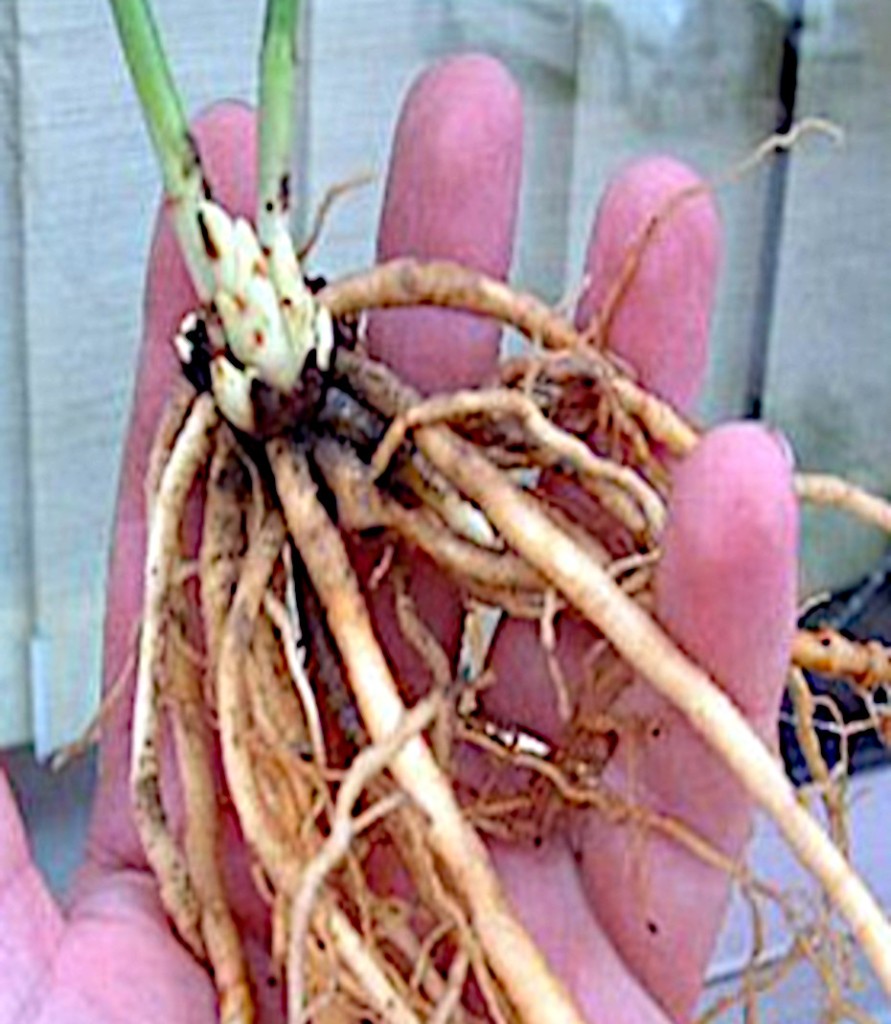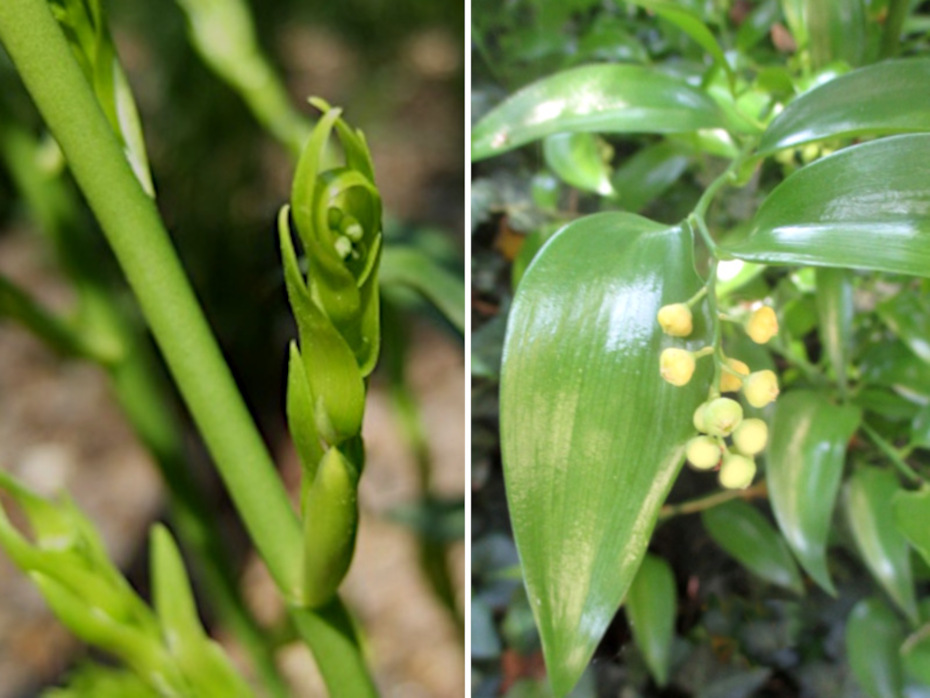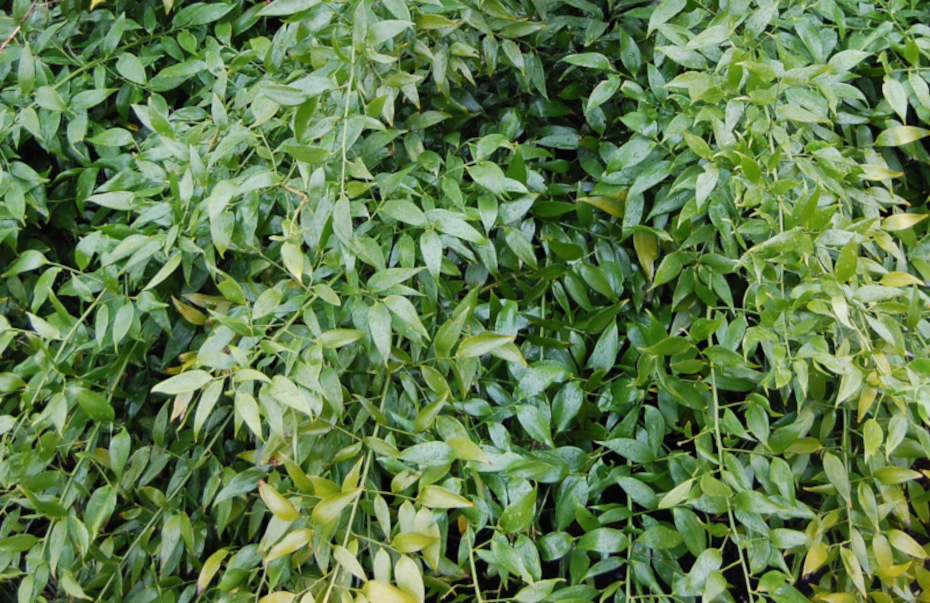It must have been 25-30 years ago. I was walking home from the office through a neighborhood adjacent to Lake Merritt in Oakland, California. This area was once full of grand houses surrounded by equally grand gardens. Vestiges of this elegant past can occasionally be encountered and one such property was being renovated the day I happened to walk by. All of the landscape had been scraped clean and a large metal dumpster on the street contained the unfortunate former plantings. Right on top, an unusual cluster of roots caught my eye. Obviously yanked rudely from its former home, it looked relatively alive and healthy. I could not resist saving it from its fate, carrying it home.

As I planted this unknown specimen in a pot, I thought the thick, fleshy roots and short rhizome looked reminiscent of an asparagus. There were fat buds seemingly ready to bust forth, so I was hopeful as I watered it well and set it in a shady spot. Over time, whenever I checked it, the plant seemed reticent to grow even though the buds continued to show great promise. Gradually, my attention became focused on other plants and projects and this rescue remained in its shady corner.
A few months later, while tidying up my menagerie of potted plants, I discovered my adoptee again, but it was unrecognizable! Several of the buds had sprouted and elongated into a number of shiny, bright green shoots! Each shoot had rounded leaf-like scales that covered miniature leafy branches tipped with a cluster of teeny-tiny flower buds. Gradually, these tender new growths expanded into a graceful stem, with multiple leafy side laterals each terminating with a short spike of rounded cream flowers.

The soft, chartreuse-green foliage gradually hardened and became a darker green. Over time, the rounded flowers gave way to bead-like green fruits that gradually turned red, and lasted for months. Eventually, these became raisined and dark maroon. Each contained one or two round, hard seeds. Casual sowing of these seeds never germinated, so I was keen to find its identity and learn more about what was needed.

Next time I was able to visit a library in those pre-Internet days, I perused various botanical references. I suspected this interesting plant was related to Ruscus (butcher’s broom) and Asparagus (asparagus ferns), though I also wondered if it might be of the genus Semele.
A few years later my wife and I traveled to France for the first time. While visiting the South of France, our friend Olivier Filippi wished to show me Le Jardin des Plantes de Montpellier, France’s first botanical garden (started in 1593). During our visit to the grounds, we also entered the herbarium adjacent to the garden, which contained thousands of pressed specimens dating back hundreds of years!

Seeing so many interesting and very important herbarium collections was mind boggling. I recalled various plants I was currently researching and looked at whatever specimens I could find in the collection. In one aisle, right at eye level, I happened to spot a folder labeled Ruscus, with another for Semele. Grouped with these was a folder labeled Danaë. When I opened it, to my dismay, it was empty!
Our allotted time evaporated far too quickly and Olivier had to physically usher me towards the exit. As he said his “Adieu” to the herbarium manager, they began a short conversation in French. While I waited, I noticed a group of books on a shelf close at hand, including a set of Histoires des Plantes (H.E. Baillon, 1892-1894). Quickly checking the index, I was able to find a entry for Ruscus (Danaë) racemosa, including a drawing that looked exactly like my plant!!

Of course, once I had this name, locating information was far easier. Apparently this species was originally placed in Ruscus but later determined to be distinct enough for its own genus: Danaë racemosa. Most descriptions of this species spent time discussing the genus name, which is from Greek mythology. It was foretold that King Acrisius’ daughter, Danaë, would give birth to a man who would kill him, so the King locked her away to protect her virginity (and himself). Zeus took up the challenge by inseminating her via a “golden shower” through the roof of her enclosure. She later gave birth to Perseus who ultimately did kill the King.

The genus Danaë was created in 1787 by a German physician and botanist Friedrich Medikus (1738-1808). I imagine he was inspired to reference the above mythological tale by the clusters of small creamy flowers of this species dangling from their delicate spikes, borne on a graceful cascade of foliage.
A Brief Botanical Nomenclature Break
Danaë racemosa (L.) Moench Methodus: 170 (1794)
dah-NAH-ey rah-KE-moe-sah (pronunciation info)
The ‘ë’ in Danaë signifies that this ‘ae’ is NOT the dipthong æ, and that the ‘ë’ is to be pronounced separately from the ‘a’, which is meant to emulate the classical Greek name of our lovely virgin.
There is nothing virginal about our plant – it bears fruit copiously each year. I have tried germinating the seed periodically but have yet to sprout a single one. Recently, I happened to see a British nursery post a photo of a group of seedling on Facebook. In on-line conversation with them I came to find out that these little plantlets are three years old!! I am told that it took a year for the seed to sprout and put down a root, and now each seem to have only two single leaves. It makes sense why this species is so uncommon in the trade. My plan is to experiment with various methods of stratification to see if the germination can be sped up, but seedling development will obviously be very slow going.

Here in Berkeley, it is March or April when our potted plant bursts forth with a new set of stems. Because, in its sheltered place, it receives little rainfall, I try to water the pot well during this time and sprinkle on some organic fertilizer to assist in growing as many new buds as possible. I also try to clear away any impediment to the tender emerging stems which can easily become deformed or break. Once the foliage hardens, the plant requires little water or attention. We keep it close to the well-traveled section of the garden so that we are aware of its cycle but also because the evergreen foliage is beautiful throughout the seasons.

Native to areas adjacent to the mediterranean climate regions in the Middle East – Iran, Syria, Turkey, Azerbaijan – this hardy plant is often grown in the UK and the Eastern US, where it is better known than in California. But its adaptability and interesting character would give it a place in our local gardens. Hopefully, as its propagation is mastered, this species will receive more attention.

References and Links
(* Information retrieval date for the URL mentioned)
Jardin des Plantes de Montpellier.
https://www.umontpellier.fr/en/universite/patrimoine/jardin-des-plantes (*January 2014)
Greek Legends and Myths. King Acrisius in Greek Mythology.
https://www.greeklegendsandmyths.com/acrisius.html (*March 2014)
Jurrasic Plants. Danae racemosa – Alexandrian Laurel.
https://jurassicplants.co.uk/products/danae-racemosa-alexandrian-laurel (*May 2014)
Shen, Xiuli, Guochen Yang, and Zhongge (Cindy) Lu. “In Vitro Propagation of Alexandrian Laurel (Danae racemosa L. Moench), a Valuable Ornamental Plant”. HortScience horts 48.10 (2013): 1301-1303.
https://doi.org/10.21273/HORTSCI.48.10.1301 (*August 2014)
